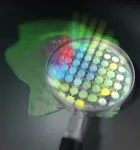A way around the conventional problem is to focus on fluorescence lifetime instead of intensity. When a fluorescent substance is irradiated with a short burst of light, the resulting fluorescence does not disappear immediately but actually "decays" over time in a way that is specific to that substance. The "fluorescence lifetime microscopy" technique leverages this phenomenon--which is independent of experimental conditions--to accurately quantify fluorescent molecules and changes in their environment. However, fluorescence decay is extremely fast, and ordinary cameras cannot capture it. While a single-point photodetector can be used instead, it has to be scanned throughout the sample's area to be able to reconstruct a complete 2D picture from each measured point. This process involves movement of mechanical pieces, which greatly limits the speed of image capture.
Fortunately, in this recent study published in Science Advances, the aforementioned team of scientists developed a novel approach to acquire fluorescence lifetime images without necessitating mechanical scanning. Professor Takeshi Yasui, from Institute of Post-LED Photonics (pLED), Tokushima University, Japan, who led the study, explains, "Our method can be interpreted as simultaneously mapping 44,400 'light stopwatches' over a 2D space to measure fluorescence lifetimes--all in a single shot and without scanning." So, how was this achieved?
One of the main pillars of their method is the use of an optical frequency comb as the excitation light for the sample. An optical frequency comb is essentially a light signal composed of the sum of many discrete optical frequencies with a constant spacing in between them. The word "comb" in this context refers to how the signal looks when plotted against optical frequency: a dense cluster of equidistant "spikes" rising from the optical frequency axis and resembling a hair comb. Using special optical equipment, a pair of excitation frequency comb signals is decomposed into individual optical beat signals (dual-comb optical beats) with different intensity-modulation frequencies, each carrying a single modulation frequency, and irradiated on the target sample. The key here is that each light beam hits the sample on a spatially distinct location, creating a one-to-one correspondence between each point on the 2D surface of the sample (pixel) and each modulation frequency of the dual-comb optical beats.
Because of its fluorescence properties, the sample re-emits part of the captured radiation while still preserving the aforementioned frequency-position correspondence. The fluorescence emitted from the sample is then simply focused using a lens onto a high-speed single-point photodetector. Finally, the measured signal is mathematically transformed into the frequency domain, and the fluorescence lifetime at each "pixel" is easily calculated from the relative phase delay that exists between the excitation signal at that modulation frequency versus the one measured.
Thanks to its superior speed and high spatial resolution, the microscopy method developed in this study will make it easier to exploit the advantages of fluorescence lifetime measurements. "Because our technique does not require scanning, a simultaneous measurement over the entire sample is guaranteed in each shot," remarks Prof. Yasui, "This will be helpful in life sciences where dynamic observations of living cells are needed." In addition to providing deeper insight into biological processes, this new approach could be used for simultaneous imaging of multiple samples for antigen testing, which is already being used for the diagnosis of COVID-19.
Perhaps most importantly, this study showcases how optical frequency combs, which were only being used as "frequency rulers," can find a place in microscopy techniques to push the envelope in life sciences. It holds promise for the development of novel therapeutic options to treat intractable diseases and enhance life expectancy, thereby benefitting the whole of humanity.
INFORMATION:
About Tokushima University, Japan
Established in 1949 by merging multiple education facilities into one, Tokushima University has grown to become one of Japan's most prestigious universities. Its current vision is the search for truth, the creation of knowledge, and the development of eminent sciences and cultures with a spirit of independence and autonomy, all for the peaceful development of humanity and the solution of social issues. Tokushima University counts with seven faculties, eight graduate schools, and an institute of liberal arts and sciences distributed across three main campuses, serving 5,900 undergraduate students and over 2,000 graduate students. The university also counts with over 200 international students from 29 countries. Tokushima University is open to the whole world and works hard to create a rich and peaceful society for the future.
Website: https://www.tokushima-u.ac.jp/english/
About Institute of Post-LED Photonics (pLED), Tokushima University, Japan
This institute was established in Tokushima University in March 2019 to open a new field of invisible next-generation light, i.e., deep ultraviolet, infrared, and terahertz. Research in pLED includes development and application of the practical light source in that wavelengths. pLED also develop innovative medical techniques by combining optical science with medical science. All researchers with different expertise carry out cutting-edge optical science, while sharing the same vision and direction. pLED will develop interdisciplinary research beyond one specialized field through close communication and interaction between researchers with various backgrounds.
Website: https://www.pled.tokushima-u.ac.jp/wp-content/themes/plp/pdf/pamph_english.pdf
About Professor Takeshi Yasui from Tokushima University
Prof. Takeshi Yasui graduated from Tokushima University, Japan, in 1992 and proceeded to get two doctoral degrees: one in Engineering from Tokushima University in 1997 and one in Medical Science from Nara Medical University in 2013. Since 2019, he has been Director of Institute of Post-LED Photonics (pLED), Tokushima University. He has published over 100 peer-reviewed papers and is currently interested in research on optical frequency comb, terahertz instrumentation, and nonlinear optical microscopy.
https://femto.me.tokushima-u.ac.jp/eng/index.html
Funding information
The study was supported by grants for the Exploratory Research for Advanced Technology (ERATO), Japan Science and Technology Agency (MINOSHIMA Intelligent Optical Synthesizer Project, JPMJER1304), Japan Society for the Promotion of Science (18H01901, 18K13768, 19H00871), Cabinet Office, Government of Japan (Subsidy for Regional University and Regional Industrial Creation), Nakatani Foundation for Advancement of Measuring Technologies in Biomedical Engineering, and Research Clusters program of Tokushima University (1802003).

